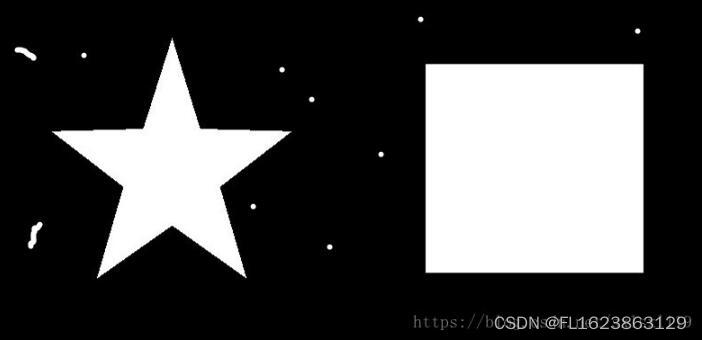这是后期补充的部分,和前期的代码不太一样
效果图

源代码
//测试
void CCutImageVS2013Dlg::OnBnClickedTestButton1()
{
vector<vector<Point> > contours; //轮廓数组
vector<Point2d> centers; //轮廓质心坐标
vector<vector<Point> >::iterator itr; //轮廓迭代器
vector<Point2d>::iterator itrc; //质心坐标迭代器
vector<vector<Point> > con; //当前轮廓
double area;
double minarea = 1000;
double maxarea = 0;
Moments mom; // 轮廓矩
Mat image, gray, edge, dst;
image = imread("D:\\66.png");
cvtColor(image, gray, COLOR_BGR2GRAY);
Mat rgbImg(gray.size(), CV_8UC3); //创建三通道图
blur(gray, edge, Size(3, 3)); //模糊去噪
threshold(edge, edge, 200, 255, THRESH_BINARY_INV); //二值化处理,黑底白字
//--------去除较小轮廓,并寻找最大轮廓--------------------------
findContours(edge, contours, CV_RETR_EXTERNAL, CV_CHAIN_APPROX_SIMPLE); //寻找轮廓
itr = contours.begin(); //使用迭代器去除噪声轮廓
while (itr != contours.end())
{
area = contourArea(*itr); //获得轮廓面积
if (area<minarea) //删除较小面积的轮廓
{
itr = contours.erase(itr); //itr一旦erase,需要重新赋值
}
else
{
itr++;
}
if (area>maxarea) //寻找最大轮廓
{
maxarea = area;
}
}
dst = Mat::zeros(image.rows, image.cols, CV_8UC3);
/*绘制连通区域轮廓,计算质心坐标*/
Point2d center;
itr = contours.begin();
while (itr != contours.end())
{
area = contourArea(*itr);
con.push_back(*itr); //获取当前轮廓
if (area == maxarea)
{
vector<Rect> boundRect(1); //定义外接矩形集合
boundRect[0] = boundingRect(Mat(*itr));
cvtColor(gray, rgbImg, COLOR_GRAY2BGR);
Rect select;
select.x = boundRect[0].x;
select.y = boundRect[0].y;
select.width = boundRect[0].width;
select.height = boundRect[0].height;
rectangle(rgbImg, select, Scalar(0, 255, 0), 3, 2); //用矩形画矩形窗
drawContours(dst, con, -1, Scalar(0, 0, 255), 2); //最大面积红色绘制
}
else
drawContours(dst, con, -1, Scalar(255, 0, 0), 2); //其它面积蓝色绘制
con.pop_back();
//计算质心
mom = moments(*itr);
center.x = (int)(mom.m10 / mom.m00);
center.y = (int)(mom.m01 / mom.m00);
centers.push_back(center);
itr++;
}
imshow("rgbImg", rgbImg);
//imshow("gray", gray);
//imshow("edge", edge);
imshow("origin", image);
imshow("connected_region", dst);
waitKey(0);
return;
}
前期做的,方法可能不太一样
一,先看效果图
原图

处理前后图

二,实现源代码
//=======函数实现=====================================================================
void RemoveSmallRegion(Mat &Src, Mat &Dst, int AreaLimit, int CheckMode, int NeihborMode)
{
int RemoveCount = 0;
//新建一幅标签图像初始化为0像素点,为了记录每个像素点检验状态的标签,0代表未检查,1代表正在检查,2代表检查不合格(需要反转颜色),3代表检查合格或不需检查
//初始化的图像全部为0,未检查
Mat PointLabel = Mat::zeros(Src.size(), CV_8UC1);
if (CheckMode == 1)//去除小连通区域的白色点
{
//cout << "去除小连通域.";
for (int i = 0; i < Src.rows; i++)
{
for (int j = 0; j < Src.cols; j++)
{
if (Src.at<uchar>(i, j) < 10)
{
PointLabel.at<uchar>(i, j) = 3;//将背景黑色点标记为合格,像素为3
}
}
}
}
else//去除孔洞,黑色点像素
{
//cout << "去除孔洞";
for (int i = 0; i < Src.rows; i++)
{
for (int j = 0; j < Src.cols; j++)
{
if (Src.at<uchar>(i, j) > 10)
{
PointLabel.at<uchar>(i, j) = 3;//如果原图是白色区域,标记为合格,像素为3
}
}
}
}
vector<Point2i>NeihborPos;//将邻域压进容器
NeihborPos.push_back(Point2i(-1, 0));
NeihborPos.push_back(Point2i(1, 0));
NeihborPos.push_back(Point2i(0, -1));
NeihborPos.push_back(Point2i(0, 1));
if (NeihborMode == 1)
{
//cout << "Neighbor mode: 8邻域." << endl;
NeihborPos.push_back(Point2i(-1, -1));
NeihborPos.push_back(Point2i(-1, 1));
NeihborPos.push_back(Point2i(1, -1));
NeihborPos.push_back(Point2i(1, 1));
}
else int a = 0;//cout << "Neighbor mode: 4邻域." << endl;
int NeihborCount = 4 + 4 * NeihborMode;
int CurrX = 0, CurrY = 0;
//开始检测
for (int i = 0; i < Src.rows; i++)
{
for (int j = 0; j < Src.cols; j++)
{
if (PointLabel.at<uchar>(i, j) == 0)//标签图像像素点为0,表示还未检查的不合格点
{ //开始检查
vector<Point2i>GrowBuffer;//记录检查像素点的个数
GrowBuffer.push_back(Point2i(j, i));
PointLabel.at<uchar>(i, j) = 1;//标记为正在检查
int CheckResult = 0;
for (int z = 0; z < GrowBuffer.size(); z++)
{
for (int q = 0; q < NeihborCount; q++)
{
CurrX = GrowBuffer.at(z).x + NeihborPos.at(q).x;
CurrY = GrowBuffer.at(z).y + NeihborPos.at(q).y;
if (CurrX >= 0 && CurrX<Src.cols&&CurrY >= 0 && CurrY<Src.rows) //防止越界
{
if (PointLabel.at<uchar>(CurrY, CurrX) == 0)
{
GrowBuffer.push_back(Point2i(CurrX, CurrY)); //邻域点加入buffer
PointLabel.at<uchar>(CurrY, CurrX) = 1; //更新邻域点的检查标签,避免重复检查
}
}
}
}
if (GrowBuffer.size()>AreaLimit) //判断结果(是否超出限定的大小),1为未超出,2为超出
CheckResult = 2;
else
{
CheckResult = 1;
RemoveCount++;//记录有多少区域被去除
}
for (int z = 0; z < GrowBuffer.size(); z++)
{
CurrX = GrowBuffer.at(z).x;
CurrY = GrowBuffer.at(z).y;
PointLabel.at<uchar>(CurrY, CurrX) += CheckResult;//标记不合格的像素点,像素值为2
}
//********结束该点处的检查**********
}
}
}
CheckMode = 255 * (1 - CheckMode);
//开始反转面积过小的区域
for (int i = 0; i < Src.rows; ++i)
{
for (int j = 0; j < Src.cols; ++j)
{
if (PointLabel.at<uchar>(i, j) == 2)
{
Dst.at<uchar>(i, j) = CheckMode;
}
else if (PointLabel.at<uchar>(i, j) == 3)
{
Dst.at<uchar>(i, j) = Src.at<uchar>(i, j);
}
}
}
//cout << RemoveCount << " objects removed." << endl;
}
//=======函数实现=====================================================================
//=======调用函数=====================================================================
Mat img;
img = imread("D:\\1_1.jpg", 0);//读取图片
threshold(img, img, 128, 255, CV_THRESH_BINARY_INV);
imshow("去除前", img);
Mat img1;
RemoveSmallRegion(img, img, 200, 0, 1);
imshow("去除后", img);
waitKey(0);
//=======调用函数=====================================================================










